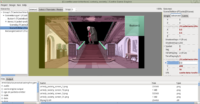 |
 |
-
The editor supports selecting, translating and resizing UI controls (possibly with snap). You may have already seen it in the movie.
-
It is possible to use custom components within the editor.
New build tool command “castle-engine editor” will run Castle Game Engine Editor within the current project, with possible project-specific components. It will automatically build CGE editor with additional project-specific components included.
See the editor README, section “Include custom (project-specific) components in the visual designer”.
-
The editor has menu items to adjust camera (Scene Manager Camera View All), and to reorder 2D scenes (Scene Manager Sort For Correct 2D Blending).
-
Much more vectors and colors are editable and persistent in the editor. E.g.
TCastleLabel.Color,TCastleTransform.Translation/Rotation/Scale. -
New property TCastleUserInterface.AutoSizeToChildren allows to adjust size to include all children. In particular useful for TCastleScrollView.ScrollArea.
-
The user interface coordinates (all positions, sizes) are float-based now. In other words, TCastleUserInterface.Width, TCastleUserInterface.Height, and a lot of “friends” now have a type Single, not Integer. In some cases, we deprecated old integer-based property (like TCastleUserInterface.CalculatedWidth, TCastleUserInterface.ScreenRect) and added a new float-based replacement (like TCastleUserInterface.EffectiveWidth, TCastleUserInterface.RenderRect).
Note: This change may break backward compatibility in some cases. You may need to adjust your code. This was unfortunately unavoidable, the API looked really messy when I was trying to maintain 100% backward compatibility (having both integer-based and float-based methods and properties). Details in this commit log.
If you just did
MyControl.Width := 100it will work as before. But if you did e.g.MyInteger := MyControl.Width, orMyInteger := MyControl.Width div 2, it will no longer work, asWidthis a floating-point value (Single) now. You will need to adjust your code. You can just writeRound(MyControl.Width), or you can adjust your code to use float-based coordinates everywhere too.If you use rectangles, you can convert between integer-based (
TRectangle) and float-based (TFloatRectangle) usingMyFloatRectangle := FloatRectangle(MyIntRectangle)orMyIntRectangle := MyFloatRectangle.Round;.If you encounter troubles adjusting your code, please let us know on Discord or forums, we will help!
-
TCastleUserInterfacenow has a size (Width, Height, FullSize properties). TheTCastleUserInterfaceRect,TUIControl,TUIControlRectare all now just deprecated aliases forTCastleUserInterface. -
All UI controls have non-zero size by default. The base
TCastleUserInterfaceclass sets width and height to 100. This is more friendly (especially when using the editor) than previous situation whenTCastleUserInterfaceRect/TUIControlRecthad by default zero size.